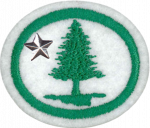Especialidades JA/Árboles - Avanzado/Respuestas
| Árboles- Avanzado | ||
|---|---|---|
| Asociación General
|
Destreza: 3 Año de introducción: 1949 |
|
Requisitos
1
Para consejos e instrucciones, véase Árboles.
2
3
3a
3b
3c
3d
3e
3f
3g
3h
3i
3j
3k
3l
4
4b. Of what use are the two parts of a scientific name?
The first part of the scientific name is the genus, and the second part is the species. We have already discussed Quercus alba - the white oak, so let's expand on that. There are many, many different species of oak, and they are all in the genus Quercus. All these trees produce acorns, and they are closely related to one another. Grouping them into a common genus recognizes their similarities, while separating them by species recognizes their differences.
5
Angiosperms
- Beech Family
- Beeches, Chestnuts, Chinkapins, and Oaks
- Birch Family
- Alders, Birches, Hornbeams, and Hazelnuts
- Cashew Family
- Smoketree and Sumacs
- Custard-Apple Family
- Pawpaw and Pond apple
- Elm Family
- Elms and Hackberries
- Horsechestnut Family
- Buckeyes and Horsechestnuts
- Laurel Family
- Laurels, Redbay, and Sassafras
- Legume Family
- Acacias, Redbuds, and Locusts
- Magnolia Family
- Magnolias, and Yellow (Tulip) Poplar
- Maple Family
- Maples
- Mulberry Family
- Figs, Mulberries, and Osage Oranges
- Palm Family
- Coconuts, Dates, Palms, and Palmettos
- Rose Family
- Apples, Peaches, Pears, and Plums
- Sycamore Family
- Sycamores
- Walnut Family
- Hickories, and Walnuts
- Willow Family
- Aspens, Poplars, and Willows
6
A leaf is the part of a plant specialized for photosynthesis. For this purpose, a leaf is typically flat and thin, to expose the cells containing chloroplast to light over a broad area, and to allow light to penetrate fully into the tissues. Leaves can store food and water.
7
This is a partial list of trees with opposite leaves. There may be more in your area.
8
8a
8b
8c
8d
8e
Examination of the cross-section of a log will reveal dark wood near the center, and light-colored wood near the bark. The dark wood near the center is heartwood. As a tree increases in age and diameter an inner portion of the sapwood becomes inactive and finally ceases to function, as the cells die. This inert or dead portion is called heartwood.
8f
8g
8h
8i
8j
8k
8l
9
9a
9b
9c
9d
9e
9f
9g
9h
10
By bark
The bark of many trees is easily recognizable, and in some cases, using the bark to identify the tree is easier than using the leaves.
Referencias
- Categoría: Tiene imagen de insignia
- Adventist Youth Honors Answer Book/Honors/es
- Adventist Youth Honors Answer Book/es
- Adventist Youth Honors Answer Book/Skill Level 3/es
- Categoría: Libro de respuestas de especialidades JA/Especialidades introducidas en 1949
- Adventist Youth Honors Answer Book/General Conference/es
- Adventist Youth Honors Answer Book/Nature/es
- Adventist Youth Honors Answer Book/Nature/Primary/es
- Adventist Youth Honors Answer Book/Stage 0/es
- AY Honors/Prerequisite/Trees/es
- AY Honors/See Also/Trees/es

